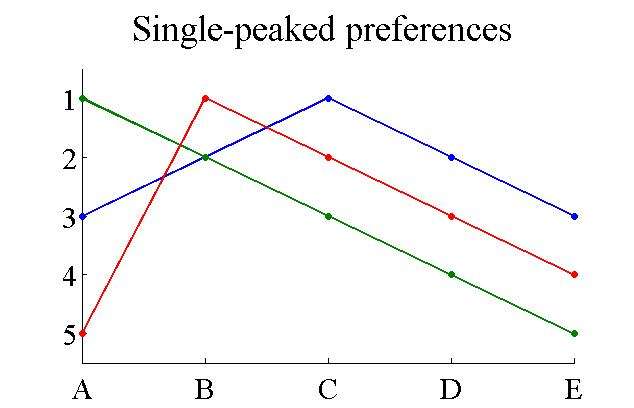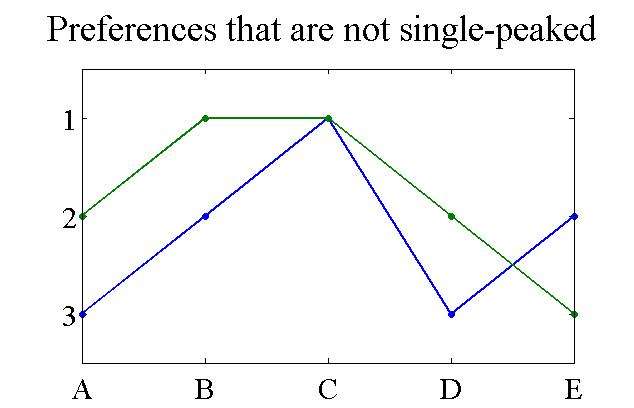Single peaked preferences
Single-peaked preferences are a kind of preference relations. A group of agents is said to have single-peaked-preferences if:
- Each agent has an ideal choice in the set; and
- For each agent, outcomes that are further from his ideal choice are preferred less.
Single-peaked preferences are typical of one-dimensional domains. A typical example is when several consumers have to decide on the amount of public good to purchase. The amount is a one-dimensional variable. Usually, each consumer decides on a certain quantity which is best for him, and if the actual quantity is more/less than that ideal quantity, the agent is then less satisfied.
With single-peaked preferences, there is a simple truthful mechanism for selecting an outcome: it is to select the median quantity. See the median voter theorem. It is truthful because the median function satisfies the strong monotonicity property.
Formal definition
Take an ordered set of outcomes: . An agent has a "single-peaked" preference relation over outcomes, , or "single-peaked preferences", if there exists a unique such that
In words, is the ideal point. When the agent compares between two outcomes that are both to the right or to the left of the ideal point, she strictly prefers whichever option is closest to .
Some examples
The following graphs show three preferences that are single-peaked over outcomes {A,B,C,D,E}. On the vertical axis, the number represents the preference ranking of the outcome, with 1 being most preferred. Two outcomes that are equally preferred have the same ranking.

The following graph gives two examples of preferences that are not single-peaked. The blue preferences are clearly not single-peaked because the preference ranking spikes down for "D" and then spikes up for "E". The green preferences are not single-peaked because they have two outcomes that are the most preferred: "B" and "C". Such preferences are sometimes called single-plateaued.

Interpretations
Single-peaked preferences have a number of interpretations for different applications.
A simple application of ideological preferences is to think of the outcome space as locations on a street and each as the address of an individual. Suppose a single bus stop has to be located on the street and every individual wishes to walk as little as possible to the stop. Individuals then have single-peaked preferences: individual 's ideal point is and she dislikes other locations the farther they are to the west or the farther they are to the east.
The outcome space can also be thought as different policies in an ideological spectrum: policies from the Left vs policies from the Right; policies that are more liberal vs policies that are more conservative; policies that are pro free markets vs policies that are pro state intervention. Voters have single-peaked preferences if they have an ideal balance between the two directions of the ideological spectrum and if they dislike policies the farther away they are from their ideal point.
See also
References
- Austen-Smith, David & Jeffrey Banks (2000). Positive Political Theory I: Collective Preferences. University of Michigan Press. ISBN 978-0-472-08721-1.
- Mas-Colell, Andreu, Michael D. Whinston, and Jerry R. Green (1995). Microeconomic Theory. Oxford University Press. ISBN 978-0-19-507340-9.
- Moulin, Hervé (1991). Axioms of Cooperative Decision Making. Cambridge University Press. ISBN 978-0-521-42458-5.